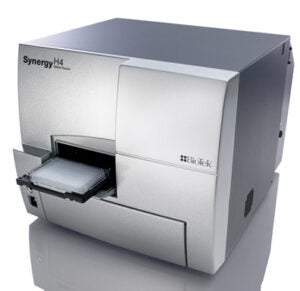 All You Need in One Compact Instrument
All You Need in One Compact Instrument
BioTek Synergy H4 covers the broadest range of applications. Equipped with two main optical systems (monochromater-based and filter-based) and 6 major detection modes (UV-Visible absorbance, top/bottom fluorescence, luminescence, fluorescence polarization (FP), time-resolved fluorescence (TRF), and Alpha) it can run virtually any microplate-based assay from basic research assays to high throughput drug discovery assays.
Hybrid Technology: Sensibility and Flexibility
Hybrid Technology BioTek’s patented design that combines two different optical systems in one compact instrument. This design makes Synergy H4 the ideal instrument for research and drug discovery applications when having to choose between flexibility and performance is not an option.
Alpha Detection Mode
Alpha-based assays (AlphaScreen, AlphaLISA, SureFire) are growing in popularity because of the workflow simplicity (homogeneous, no-wash assays), and the level of sensitivity they provide for cellular assays. With its unique optical system, Synergy H4 is the optimal reader to provide high-performance detection for Alpha-based assays.
Detection modes:
- Fluorescence Intensity
- Fluorescence Polarization (FP)
- Time-Resolved Fluorescence TRF)
- Luminescence
- UV-Visible Absorbance
- AlphaScreen/ AlphaLISA
Typical applications:
- Nucleic acid quantification
- Protein quantification
- Enzyme kinetics
- Biomarker quantification
- ELISAs
- Genetics analysis
- Drug discovery
- Cell proliferation
- Cytotoxicity
- Drug absorption and metabolism
- Biologics drug discovery and development
- Food safety
- Biofuels research
- Environmental monitoring
Specifications:
Absorbance
- Wavelength selection Monochromator
- Wavelength range 230 ̶ 999 nm, 1 nm increment
- Bandpass 2 nm (230 ̶ 285 nm), 4 nm (>285 nm)
- Dynamic range 0 ̶ 4.0 OD
- Resolution 0.0001 OD
- Path length correction Yes
- Reading speed
o 96 well plate: 11 seconds
o 384 well plate: 22 seconds
Fluorescence Intensity
- Sensitivity Monochromators:
o Fluorescein 2 pM typical (0.2 fmol/well 384-well plate) – Top
o Fluorescein 2.5 pM typical (0.25 fmol/well 384-well plate) – Bottom
- Sensitivity Filters/mirrors:
o Fluorescein 1 pM typical (0.1 fmol/well 384-well plate)
- Light sources
o Tungsten Halogen lamp
o High energy Xenon flash lamp
- Wavelength selection
o Double grating monochromators and,
o Deep blocking bandpass filters/dichroic mirrors
- Wavelength range
o Monochromators: 250 ̶ 900 nm
o Filters: 200 ̶ 700 nm (900 nm option)
- Bandpass
o Monochromators: variable 9, 13.5, 17, 20 nm
o Filters: filter-dependent, from 5 nm to >100 nm
- Detection system
o Red shifted PMT for monochromator-based system
o Low Noise PMT for filter-based system
- Dynamic range
o Monochromators: 5 decades
o Filters/mirrors: >6 decades
- Reading speed
o 96 well plate: 11 seconds
o 384 well plate: 22 seconds
o 1536 well plate: 43 seconds
Luminescence
- Sensitivity 10 amol ATP typical (flash)
Fluorescence Polarization
- Light source Tungsten Halogen
- Sensitivity 3 mP at 1 nM fluorescein typical
- Wavelength selection Deep blocking bandpass filters/dichroic mirrors
Time-Resolved Fluorescence
- Light source High energy Xenon flash
- Sensitivity Europium 60 fM typical with filters (6 amol/well in 384-well plate)
Manual and presentations are available. SynergyH4__Demo, Synergy H4 Applications and Gen5™ Getting Started Guide.
For more information go to www.biotek.com